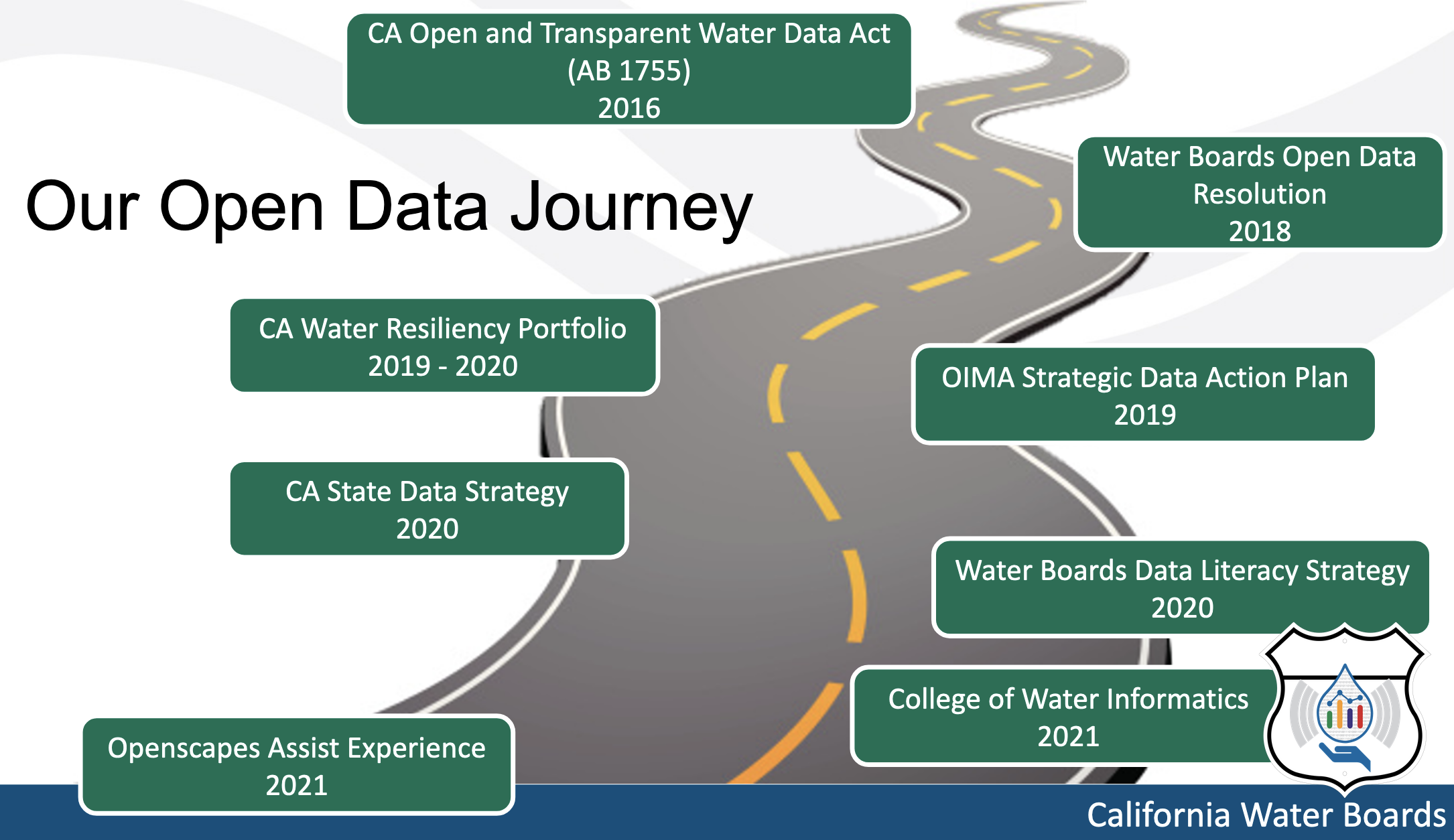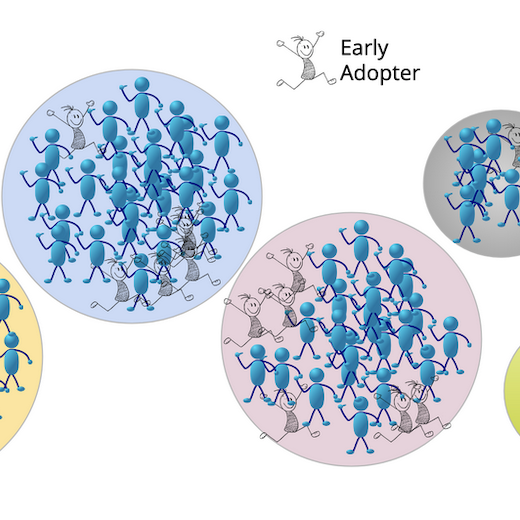At the ESIP Winter Meeting, “Data for All People: From Data Generation to Data Use and Understanding”, we held a session called “Better Science for Future Us: Planning for the Year of Open Science”, with speakers from University of North Carolina (UNC), National Oceanic and Atmospheric Administration (NOAA) Fisheries, California Water Boards, University of Colorado, and United States Geological Survey (USGS). The goals of this session were to increase visibility and value of open science within government and support researchers and leaders that are already doing this within government organizations; to create more channels for inter- and cross-agency learning; and to share open science stories across agencies as we prepare for NASA’s Year of Open Science initiative. Speakers shared stories about open science in government and their experiences with Openscapes. These examples were shared in a “Fishbowl” format, where speakers each shared and then there was a broader discussion with the 70+ participants.
Quick links:
ESIP Session page - links to with video recording and notes
Slides:
3 takeaways for planning for the year of open science
Our ESIP session provided space to bring four different groups together who are working with Openscapes so that they could share their stories and discuss their implementation of open science practices with a broader audience of allies. These folks are “early adopters” who are investing the time and effort needed to help colleagues transition to open science. This session aimed to increase the visibility of open science within government, support open science leaders within government organizations, and create more channels for inter- and cross-agency learning.
A strong theme throughout the whole session was equity. Ileana Fenwick underscored how open science has not been accessible to everyone in science and discussed her ongoing work to build equitable pathways for researchers at Historically Black Colleges and Universities (HBCUs), and the importance of providing support and aftercare. Eli Holmes described how equity must become a focus within NOAA as well; while some science centers have had a high density of early adopters and lots of resources including code sharing and peer mentors, other centers or labs have had fewer early adopters or their coders have not been connected to the others. Anna Holder’s work at the California Water Boards centers equity. Anna sees the true spirit of open science as being at the nexus of open data and science; effective science communication; and equity, specifically centered around racial equity and environmental justice.
Here are 3 overlapping takeaways from this session that all speakers embodied. We describe these more fully below.
Both top-down and grassroots efforts are necessary
Dissolve silos by supporting early adopters
Reuse and build from existing efforts to accelerate change
Both top-down and grassroots efforts are necessary
Both top-down and grassroots efforts supporting open science are necessary - and need open and active communication channels. Our session started off framing NASA-Openscapes as “top-down” since NASA’s Earth Science Data Systems (ESDS) leadership supports open science through official policy and initiatives (see the 2021 NASA ESDS Program Highlights), and framing efforts at NOAA Fisheries as “grassroots” as early adopter researchers find each other and join forces to make the case for open science to leadership.
But as we talked, the importance of and need for both really came through.
When Amy Steiker and Aaron Friesz, from NASA’s Distributed Active Archive Centers (DAACs), discussed their work with NASA Openscapes, Amy mentioned that while there is critical top-down support from NASA leadership, managers look to researchers at the grassroots level to determine what open science can look like. Additionally, NASA staff have been asking for open source tooling and workflows to support researchers, including JupyterHubs where they can develop open source code on the Cloud. Now as Aaron, Amy, and colleagues have access to a JupyterHub to develop and teach tutorials for NASA Earthdata (like they did at the 2021 Cloud Hackathon), they are able to share progress and lessons learned, and get feedback and support from their NASA teams, managers, and leadership. So, while from the outside this might look strictly top-down, NASA is a really exciting example of how both are needed and how creating channels for them to listen and iterate together is really key.
Dissolve silos by supporting early adopters
Silos within organizations can be dissolved by supporting early adopters that already exist. Eli Holmes introduced open science early adopters as part of the diffusion of innovation theory, that there is a predictable progression of stages as an idea diffuses through a population or organization (see image below). Early adopters play a critical role in not only uptake of new ideas and technologies like open science, but also in championing and communicating the vision of what is possible to reach leadership, who are part of the majority and key to organization-wide decision making, policies, and culture. She described the spread of open science and open source workflows at NOAA Fisheries and how early adopters do exist but tend to be siloed and can have trouble finding each other - in part due to lack of communication channels like email lists or cross-program technical groups. In a grassroots fashion, Eli and colleagues have created the NOAA Fisheries Openscapes GitHub organization as a place to share analytical and teaching resources for scientists across the agency, support open science communities such as the agency R User Group and RStudio Connect community, and build visibility for open science work already going on at NOAA Fisheries.

Slides from Eli Holmes’ presentation showing the diffusion of innovation theory and that early adopters can be isolated.
Anna Holder said of the California Water Boards, “like many complex organizations, we too have complex data systems and infrastructure”. She described their open data journey and how this has been part of their organizational fabric for over five years. In addition to official strategies, communication and teaching with different audiences within the organization has been key. Anna and colleagues are leading “data literacy” workshops for executives — not to teach tools like R and GitHub but to discuss that these tools exist and showing use cases that make their staff more efficient, for example where data quality control can be done in minutes rather than weeks. This work often involves “slowing down in order to speed up”, and underscores not only the importance of early adopters but the role early adopters play in teaching and supporting colleagues as whole organizations transition to open science.

Slide from Anna Holder’s presentation showing the California Water Boards’ open data journey
It is critical to recognize that early adopters already exist. They are bright spots that get brighter when working together and collectively spread more brightness within an organization, like Anna’s work at the Water Boards, Eli’s work at NOAA Fisheries, Aaron and Amy’s work within NASA, or Ileana’s cross- organization work with HBCUs. This follows the point above that grassroots efforts are critical for building these communities and helping identify needs.
Reuse and build from existing efforts to accelerate change
Why is the Openscapes approach working? There have been many preceding and ongoing efforts, so what’s different here? This came up several times in the session live notes and we did not have much time to discuss, so we debriefed with the speakers and NASA Openscapes Mentors afterwards and have some emerging thoughts to share. We are all building off years of work by many in the open science community and beyond and are so grateful for those ongoing efforts.
A critical part is creating “space and place”. One of the key things that we do is to create space for cohorts of researchers and mentors to talk, build community, and find common needs (which also takes time and consistency). Then a place is needed to collaborate, which means using technology like Google Docs, GitHub, Slack, as well as JupyterHubs, and RStudio, depending on community norms. For the NASA Openscapes Cohort, having our 2i2c JupyterHub has been really critical; for many it has been their first exposure to the Cloud, and since they now have hands-on experience they can better support researchers who are using it too. In Ileana, Eli, and Anna’s work in marine and aquatic science, RStudio is a shared environment to work together because shared workflows, for example with RMarkdown, enable shared approaches to communicate with different audiences.
Another part is that we can reuse and build from what already works. Aaron Friesz described the benefit of being able to “peer over the wall” to see and compare what types of strategies and resources other NASA DAACs have explored. This then enables Mentors and their colleagues at other NASA data centers to incorporate and reuse what was working elsewhere, rather than all reinventing in their own silos. This can mean reusing code as well as reusing communication channel setup for different communities; for example several data centers are re-using the 2021 Cloud Hackathon book structure and facilitation as well as the lessons in upcoming workshops. There is so much previous, ongoing, and accelerating work that has been developed as part of the open movement that we can leverage — meaning technology, material, and the ability to work together.
Finally, a large part is the time investment, i.e. having time for open science as part of paid jobs. Creating “space and place” takes time. It is really important to recognize that all speakers have been given time, resources, and support by their supervisors. This has been particularly important for NASA Openscapes, where Managers at the DAACs have approved dedicating up to 80% of weekly time to open science to support learning through Carpentries Instructor Training and Openscapes Cohort Calls; Co-Working, and Clinics; developing, reviewing, and getting teaching feedback in “dry runs”; and teaching at Cloud Hackathons and workshops (see NASA Cloud tutorials).
Onward
Our team was very inspired by this session, including all of the comments and questions from both the speakers and the audience. Equitable access to open science will continue to drive our shared work going forward and we are excited for what’s to come.
Speakers Bios
Ileana Fenwick is a second-year Ph.D. student and National Science Foundation NSF Graduate Research Fellow in the Earth, Marine, and Environmental Sciences Program at UNC Chapel Hill, focusing on evaluating marine community responses to climate change and human impacts to improve our management outcomes. Ileana is also a fierce advocate for HBCUs engagement and diversity in marine science at UNC and the broader scientific community through her consulting firm.
Eli Holmes is a research fisheries scientist at NOAA Fisheries in the Northwest Fisheries Science Center (NWFSC)’s Mathematical Biology and Systems Monitoring Program. She is a long-time champion for open science and teaches R and data science to colleagues at NOAA and the University of Washington, where she is an Affiliate Professor in the School of Aquatic and Fishery Science.
Anna Holder is an Environmental Scientist in the California Water Board’s Office of Information Management and Analysis and Surface Water Ambient Monitoring Program. She is involved in building data communities within and outside of the Water Boards and was the lead staff for developing and implementing the Water Board’s College of Water Informatics
Amy Steiker is the National Snow and Ice Data Center (NSIDC) DAAC Data Services Engineer, specializing in the development and management of data education resources, tools, and services for NSIDC DAAC’s growing user community, as well as data transformation service development for NASA Earth Observing System Data and Information System (EOSDIS).
Aaron Friesz is the Science Coordination Lead at NASA’s Land Processes Distributed Active Archive Center (LP DAAC). In his role, Aaron provides user needs insights and technical support for archive and distribution, service development, and outreach activities, including developing tutorials, scripts, and presentations.
